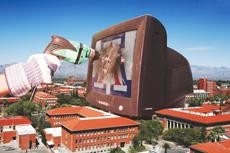Anyone vexed by the UA’s current information technology infrastructure can breathe a digital sigh of relief. University Information Technology Services is in the midst of the Mosaic Project, which will slowly replace a broad swath of outdated IT systems such as payroll and WebReg with new, better software.
“”(We’re) replacing all of our old administrative-type systems. Some of our systems are 30 years old. We want to increase the capabilities and capacities of those systems, so we’re having to replace those,”” said Kay Beasock, organizational and communications manager for the project.
Over the next two years, the computer technicians working on the Mosaic Project will implement new software to handle financial systems, human resources, research administration and student administration, she said.
“”These are brand new systems we’re putting in,”” Beasock said. “”Because (the old systems are) outdated, they’re in danger of failing. Some of these systems don’t even have vendor support anymore, and we want to remain competitive. Think about what the technology was like 30 years ago. These systems have worked and are still working, but they just don’t meet our needs anymore.””
The project is expected to cost upwards of $80 million. The Technology Oversight Committee, a sub-committee of the Arizona Board of Regents, has allocated funding for the project that will make use of loans from other sources, Beasock said.
The new software, PeopleSoft, comes from the California-based Oracle Corporation. To keep costs low, Beasock said, Project Mosaic will practice “”vanilla”” implementation, meaning that as few customizations as possible will be made to the stock software.
The most noticeable changes for students will be new looks for the schedule of classes, SAPR and WebReg, said Tom Bourgeois, co-director of the student administration portion of the project. Because construction is still underway, he was uncertain what the exact new format would look like, but he said it should be running by fall semester 2010.
“”Although it might look different, it’s still going to be functionally equivalent,”” Bourgeois said. “”We’ll just see how UA students take to it.””
Mark Barton, UA’s bursar director, said he is eager for the Mosaic Project to reach completion because he said the current system is too difficult to operate and maintain.
With the new technology, students will be able to pay off their bursars accounts 24 hours a day, unlike the current system where accounts can only be paid during business hours.
The UA will become the third Arizona university to implement PeopleSoft, following both Northern Arizona University and Arizona State University. NAU was a test school for PeopleSoft and was given special early access to the software, Bourgeois said.
Pat Benson, director of administrative computing at NAU, said the school has used PeopleSoft since 2002 and has found it to be much better and less expensive than earlier “”home-grown”” systems.
“”It works well, has a lot more functionality, and actually requires fewer staff to operate (than older systems),”” Benson said.
Having all three universities on the same system might allow for more open communication between them. However, Bourgeois said, “”the systems have never been as much of an issue, as much as the sociology.””









